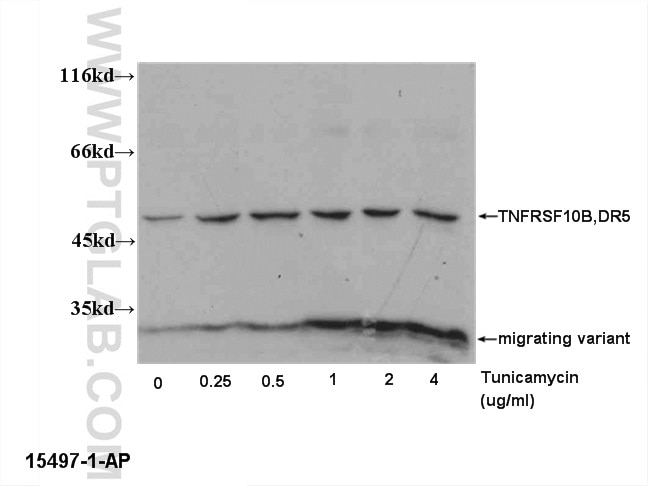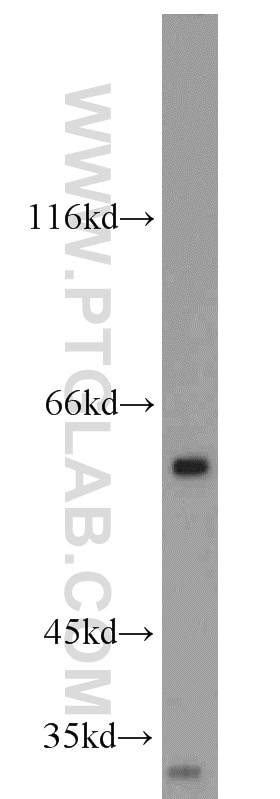Validation Data Gallery
Tested Applications
| Positive WB detected in | HL-60 cells, PC-3 cells |
Recommended dilution
| Application | Dilution |
|---|---|
| Western Blot (WB) | WB : 1:200-1:1000 |
| It is recommended that this reagent should be titrated in each testing system to obtain optimal results. | |
| Sample-dependent, Check data in validation data gallery. | |
Published Applications
| WB | See 15 publications below |
Product Information
15497-1-AP targets DR5-Specific in WB, ELISA applications and shows reactivity with human samples.
| Tested Reactivity | human |
| Cited Reactivity | human |
| Host / Isotype | Rabbit / IgG |
| Class | Polyclonal |
| Type | Antibody |
| Immunogen |
Peptide 相同性解析による交差性が予測される生物種 |
| Full Name | tumor necrosis factor receptor superfamily, member 10b |
| Calculated molecular weight | 48 kDa |
| Observed molecular weight | 58-60 kDa, 45-50 kDa, 32 kDa |
| GenBank accession number | NM_003842 |
| Gene Symbol | DR5 |
| Gene ID (NCBI) | 8795 |
| RRID | AB_2240702 |
| Conjugate | Unconjugated |
| Form | |
| Form | Liquid |
| Purification Method | Antigen affinity purification |
| UNIPROT ID | O14763 |
| Storage Buffer | PBS with 0.02% sodium azide and 50% glycerol{{ptg:BufferTemp}}7.3 |
| Storage Conditions | Store at -20°C. Stable for one year after shipment. Aliquoting is unnecessary for -20oC storage. |
Background Information
TNFRSF10B, also known as CD262, DR5, TRAILR2, TRICK2 and KILLER, is a widely expressed single-pass type I membrane protein belonging to the tumour necrosis factor receptor superfamily (TNFRSF). It is a receptor for TNF-related apoptosis-inducing ligand (TRAIL), which is a member of the tumor necrosis factor (TNF) family of cytokines and induces apoptosis in a wide variety of cells (PMID: 9311998). TNFRSF10B contains two extracellular cysteine-rich repeats, typical for TNF receptor (TNFR) family members, and a cytoplasmic death domain (DD), through which TNFRSF10B is capable to transmit the apoptotic signal (PMID: 9311998; 20531300). In PDAC cells, especially Panc89 cells, it expresses additionally to the approximately 48 and 40 kDa forms of DR5, a faster migrating variant of DR5 of about 32 kDa(PMID:20354842). The TRAIL receptor 2 (death receptor 5, or DR5) forms receptor dimers in a ligand-dependent manner, and these receptor dimers exist within high molecular weight networks(Dr. Jonathan N. Sachs,2012).
Protocols
| Product Specific Protocols | |
|---|---|
| WB protocol for DR5-Specific antibody 15497-1-AP | Download protocol |
| Standard Protocols | |
|---|---|
| Click here to view our Standard Protocols |
Publications
| Species | Application | Title |
|---|---|---|
Nat Commun A non-canonical pathway regulates ER stress signaling and blocks ER stress-induced apoptosis and heart failure. | ||
Int J Biol Sci ESRG is critical to maintain the cell survival and self-renewal/pluripotency of hPSCs by collaborating with MCM2 to suppress p53 pathway | ||
Biomed Pharmacother Pro-survival effects by NF-κB, Akt and ERK(1/2) and anti-apoptosis actions by Six1 disrupt apoptotic functions of TRAIL-Dr4/5 pathway in ovarian cancer. | ||
Mol Pharm Discovery and characterization of 4-hydroxy-2-pyridone derivative sambutoxin as a potent and promising anticancer drug candidate: activity and molecular mechanism. | ||
Arch Biochem Biophys Luteolin enhances TRAIL sensitivity in non-small cell lung cancer cells through increasing DR5 expression and Drp1-mediated mitochondrial fission. |


